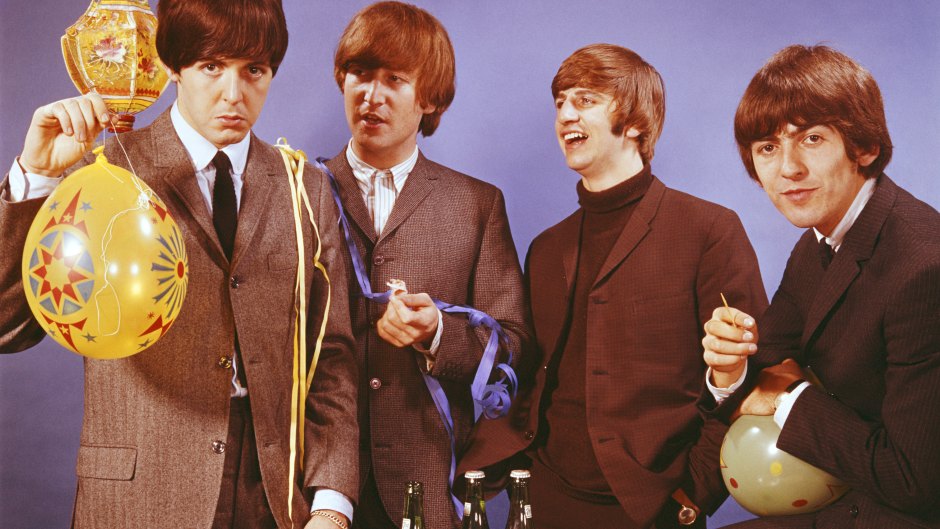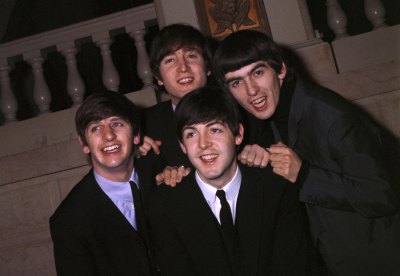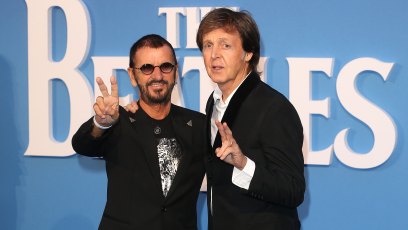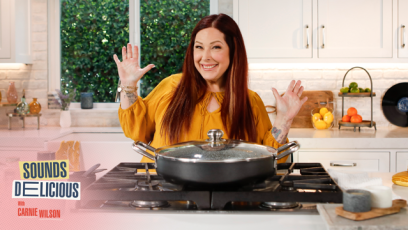
Getty Images
There Was a Time When The Beatles Could’ve Just Been Songwriters (EXCLUSIVE)
In the earliest days of The Beatles, the fact that John Lennon and Paul McCartney began composing their own material as opposed to using songs provided by other songwriters was highly unusual. In fact, at the time — the early 1960s — it simply wasn’t done. Undoubtedly in the beginning it was probably seen more as an oddity rather than an indication of the duo ultimately being credited as one of the great songwriting teams of all time.
“It wasn’t the norm,” Bill Harry, editor of Liverpool’s Mersey Beat, the first and most recognized newspaper devoted to the local music scene, and lifelong friend of The Beatles, explains in an exclusive interview. “In America you have the Brill Building and things like that, with professional songwriters like Carole King and different people. That was the situation. The songwriters wrote the songs and the artists were given songs by the songwriters. It was similar in Britain with the A&R men. For instance, [producer] George Martin virtually insisted that The Beatles do ‘How Do You Do It’ by Mitch Murray for their first single, and they eventually had to talk him out of it. He finally agreed. When they first said they wanted to do their original numbers, he said, ‘When you do a number as good as this, I’ll let you record your own stuff.’ So that was the situation at the time; few artists of any kind wrote the numbers, whether they were groups or solo singers. It was the time of the professional songwriters and, of course, The Beatles brought about the end of that era.”

(Photo Credit: Getty Images)
Spencer Leigh, the author of a number of Fab Four-related books, including The Beatles In Hamburg and The Beatles In Liverpool, emphasizes to us that initially, The Beatles performed cover songs, though they began hitting their stride once they started writing their own material. “Billy Fury, who came from Liverpool, was about the only British performer at the time who could write really decent rock and roll songs,” Spencer explains. “Even then he was a very modest performer; he did an album called The Sound of Fury in 1960 and he actually thought that he’d look too big-headed if he had his name writing all of those songs, so he invented a psuedonym for himself and half the songs are credited to Wilber Wilberforce. He did that deliberately. It’s indicative of the times, really. The Beatles, when they started writing songs, weren’t performing them at first, and some of the songs go quite a few years back. I think ‘Love Me Do’ was written in 1958, but they didn’t start performing their own songs until toward the end of 1961, bringing them into the set. I think they were encouraged by performing in Hamburg, because they had to work such long hours. When you get to your fourth hour of the night, you’re desperate to put anything out there just to fill the time. So they started to do the songs and found that people liked them.”
According to Bill, John and Paul made the decision to collaborate soon after they met. “Paul had played John a number he’d composed called ‘I Lost My Little Girl,’ which inspired them to try writing as a team. It was during the school holidays in 1957, prior to John enrolling at Liverpool College of Art, that they began meeting to compose songs, mainly at Paul’s home in Forthlin road. When terms began and Paul returned to Liverpool Institute and John began his studies at the Art College, they would both take time off school to meet up at Paul’s house, while his father was away at work. They also met to discuss their ideas in the Art College canteen or Life Rooms. Their Forthlin Road sessions usually lasted for three hours and took place between 2:00 and 5:00, before Paul’s father, Jim, returned home from work.”

(Photo Credit: Getty Images)
As Paul himself explained it in the pages of The Beatles Anthology, “Well, first I started on my own. Very early on I met John and we then, gradually, started to write stuff together. There’s a lot of random in our songs — writing, thinking, letting others think of bits — then bang, you have the jigsaw puzzle.”
Added John, “When we started off, we were uncertain as to exactly where our writing would take us. Paul was a rocker with one eye on Broadway musicals, vaudeville and s— like that. I, on the other hand, was inspired by Buddy Holly’s songwriting and was determined to show I was as capable as any Yank. To me, Buddy was the first to click as a singer-songwriter. His music really moved and his lyrics spoke to us kids in a way no one ever bothered before.”
A Complementary Approach
In a piece entitled “Two Of Us,” from Slate which looks at the relationship between John and Paul and their songwriting, it offers, “How did John Lennon and Paul McCartney make magic together? On the surface it seems simple — they covered each other’s deficits and created outlets for each other’s strengths. Paul’s melodic sunshine smoothed out John’s bluesy growls, while John’s soulful depth gave ballast to Paul and kept him from floating away. These points are true as far as they go. John and Paul did balance and complement each other magnificently, and we can pile example on example. When they were writing ‘I Saw Her Standing There,’ Paul offered this opening verse: ‘She was just seventeen/Never been a beauty queen.’ ‘You’re joking about that line,’ John shot back, ‘aren’t you?’ He offered a revision: ‘She was just seventeen/You know what I mean.’ There it is: Innocence meets sin — an inviting simple image takes a lusty, poetic leap.”

(Photo Credit: Getty Images)
John’s friend Pete Shotton, who would go on to write the book John Lennon In My Life, notes to us, “Paul’s presence did serve to keep John from drifting too far into obscurity and self-indulgence, just as John’s influence held in check the more facile and sentimental aspects of Paul’s songwriting.”
“Basically, John and Paul were completely different in the type of music they liked and the things they wanted to write,” points out Bill. “Paul’s father had been a jazz musician with a band. Paul loved Fred Astaire and Hollywood musicals and all that. He did numbers like ‘Till There Was You’ and ‘A Taste Of Honey,’ which John hated. John, of course, was an Elvis Presley freak and he loved rock and roll. They complemented each other because they had the two completely opposite musical influences, but they blended them together in a way. And of course with John, he was always trying to make a self discovery and expand things. He started by drinking pints of ale and things like that. Next it was amphetamines, then after that it was LSD and with LSD, of course, that led to ‘Lucy In The Sky With Diamonds’ and all of that. But it was all of that that made them competitive with each other as well. They’d race each other to get the lead song or as many songs on the album as possible.”
Remembered producer George Martin in a video interview, “John sneered at a lot of things, but that was part of the collaboration between the two of them. They tended to be rivals. Their collaboration as songwriters was never Rodgers and Hart, it was always Gilbert and Sullivan. If John did something, Paul would wish he’d thought of it and go away and try to do something better and vice-versa. It was a very healthy spirit of competition.”

(Photo Credit: Getty Images)
In analyzing what each brought to the creative table, John reflected, “My contribution to Paul’s songs was always to add a little bluesy edge to them. He provides a lightness, an optimism, while I would always go for the sadness, the discords, the bluesy notes. There was a period when I thought I didn’t write melodies, that Paul wrote those and I just wrote straight, shouting rock ‘n’ roll, but, of course, when I think of some of my own songs — ‘In My Life,’ or some of the early stuff, like ‘This Boy’ — I was writing melody with the best of them.”
“Most of the time we wrote separately, not in the same room together, not even aware of what the other was working on at any given time,” said Paul. “If I was stuck, I’d see what John thought. He’d do the same, bringing stuff to me for comment. If the other half of the team gave it the go-ahead, that was great. Otherwise we’d accept honest criticism from each other… The second opinion was always very important. Often it only led to lines being changed here and there. Occasionally one of us would go away and start again, but more often it was a matter of getting into the recording studio and making last-minute changes there and then on the studio floor before a session got underway. If there were things we disliked about a song, we were open with one another. It was the only possible way to make the relationship work.”
Interestingly, when John and Paul decided that they would make songwriting a priority, it ultimately led to an end of their first band, The Quarrymen, and, it seemed, performing. The duo went off to write while George Harrison joined a band called The Les Stewart Quartet.

(Photo Credit: Getty Images)
“Paul would say things like, ‘We’d like to write songs for people like Frank Sinatra,” smiles Bill, “and he wrote a song at the time with Frank Sinatra in mind called ‘Suicide.’ That’s when he was about 16. Many years later when the Lennon/McCartney and The Beatles thing were very, very big, Frank Sinatra contacted them and said, ‘I’d like a Lennon/McCartney number,’ and they sent him ‘Suicide.’ Sinatra was insulted and said, ‘Who is this guy?’ He thought they were making a fool out of him.
“But, yes, The Quarrymen broke up because John and Paul wanted to write songs,” he continues. “It wasn’t because they thought original material would make them stand out from everybody else, but more because in America there were many songwriting teams. They thought of themselves as songwriters like that. When they originally started writing songs and had finished with The Quarrymen, I don’t think they originally thought of writing songs for themselves. They were thinking of writing songs for other people.”
History is undoubtedly grateful that they changed their minds.








































